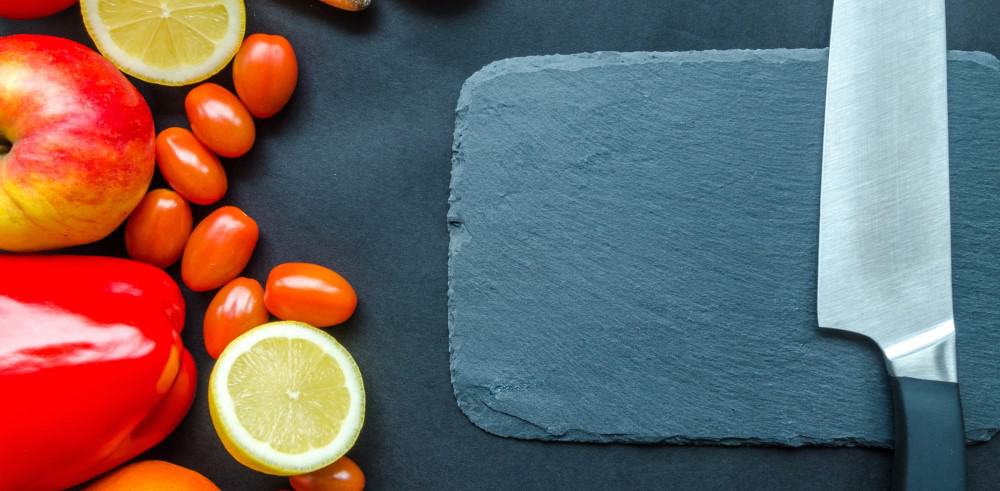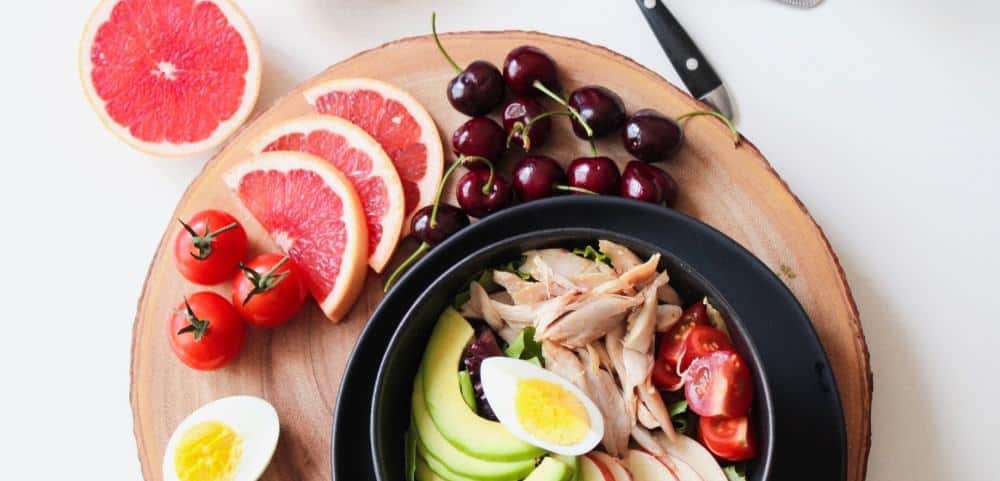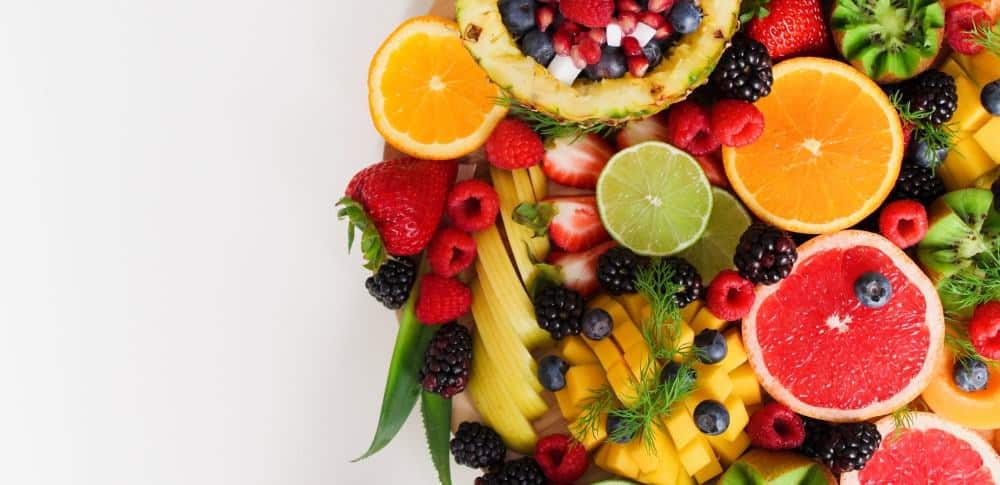Exercising goes hand in hand with the right nutrition.
If your diet is not tailored to your goal, the best training schedule won’t help. For muscle growth, calorie intake and protein intake are crucial.
Your body does not know if you are counting calories and protein or if you are unconsciously taking them in the right amount.
You do not have to count and weigh everything you eat to maintain a healthy diet and build muscle.

What are calories and what is the energy balance?
Before you get started, you need some basic knowledge of nutrition.
You only need a rough overview and do not have to understand everything to the last detail, so don’t worry. At the end of this guide, I’ll give you practical recommendations that ultimately matter.
So, for the lazy ones, you can skip right to the conclusion and check for the most important recommendations.
What is a calorie?
All foods and most drinks (except for water) have at least some calories.
The most widely used unit of measure os kcal, ie kilocalories. 1 kcal is 1000 calories. when speaking about calories, most people refer to kilocalories.
Each food is composed of different nutrients (carbohydrates, protein, and fats). Each of these nutrients provides a different amount of energy per gram (carbohydrates: 4 kcal / g, protein: 4 kcal / g, fat: 9 kcal / g).
What is energy balance?
The energy balance: how much energy goes into the body vs. how much energy is going out?
Energy balance = energy input – energy consumption
If more kcal enter the body metabolized, excess energy arises and lead to a positive energy balance.
Our body stores this excess energy mostly in body tissues (such as fat or muscle) or other forms.
If less energy is used than consumed, it leads to a negative energy balance – or a calorie deficit. To cover the need for energy, the body uses its stores (such as fat or muscle) or other forms of storage.
The art of building muscle is to build up a lot of muscle with low-fat gain.
The average daily energy consumption of a man with average activity is around 2500 kcal.
If you have a basic understanding of how many calories are your meals, it is easy to calculate how much food you can eat in order to …
- … decrease (negative energy balance = calorie deficit).
- … to keep the weight (balanced energy balance).
- … to increase (positive energy balance = calorie surplus).
Muscles grow best in an environment where there is enough energy available. You have to generate a calorie surplus.
Remember, building muscle is an energy consuming process and, from an evolutionary perspective, is not the primary goal of the body.
Your body does not want to build muscle. But with the right amount of energy and a progressive overload it needs to adapt.
Note: This does not mean that you couldn’t build muscle in a calorie deficit. Especially as an absolute beginner, this is easily possible. Later, however, muscle building requires a calory surplus.
A calorie surplus means a number of calories that go beyond your body’s calorie consumption.
For example, if your body needs 2700 kcal a day and you consume 3000 kcal from food, you have generated a calorie surplus of 400 kcal.
“15 kg of muscle in 4 weeks” or “30 kg of muscle in 10 weeks” – You can find all kinds of promises on how much muscle mass you can build all over the internet.
Let’s be honest, no natural athlete builds 15KG of muscle in 4 weeks. forget about it.
How much muscle can you really build? How fast? What should be your surplus? Should you go for a massive surplus?
There are roughly 3 ways to grow muscle. They differ mainly in a calorie surplus.
As said before, you will build muscle if you train properly and have a calory surplus. But as athletes, we don’t want to get fat.
We want just the right surplus to build muscle and stay as lean as possible.
What’s best for you depends on how experienced you are, your genetics and your workout frequency.
The 2 Extremes:
#1 Very Slow Weight Gain – “Gain Fat-Free Muscle”
You stay lean all the time and build muscle lean and fat-free. An example is the intermittent fasting method of Martin Berkhan. Here, your BFP should stay as constant as possible. Progress is slower, but theoretically, almost no cuts are necessary.
#2 Very fast weight gain – “Dirty Bulk”
Eat as much as you can. Your BFP will rise, but you will also get much stronger and build up muscle mass. Afterward, you cut over a long period of time.
#3 The Athlete Way – “The moderate weight gain”
You set a BFP range and build up muscle mass in shorter phases and then you enter a mini cut. The mini cut means a short fat loss diet for around 1 – 2 weeks. This is definitely my favorite! All in all, you can fluctuate between a body fat percentage of 9% and 12%. You can go a bit lower or higher, but we want to stay relatively lean all year long.
Before we dive deeper into the Athlete Way, you’ll need a brief introduction to P-Ratio.

The concept of P-Ratio (“Partitioning Ratio”)
When you build new muscle tissue, you almost never get around fat gain.
Why?
That’s because of the P ratio – it determines where calories are stored and distributed.
Does the energy or flow into muscles or into the fat cells?
This depends on the receptiveness of your muscle and fat tissue cells.
So somebody with the same surplus will get different amounts of Muscle mass vs. Fat mass.
With a very good P ratio, you would when for example gaining 1 kg: build up 0.7 kg of muscle mass and 0.3 kg of fat.
With a worse P-Ratio, you would only gain 0.4 kg of muscle and 0.6 kg of fat.
What does the P-ratio depend on?
The P ratio is very much dependent on your genetics. This explains why there are some people who can eat a lot, but only gain muscle mass.
It also explains why there are some people who make little progress even though they are doing everything right.
You have no influence on your genetic predispositions. Focus on what you can do to improve your p-ratio.
You may be able to adjust 15-20% through the right training, diet and general lifestyle. Many illegal substances are effective because they greatly improve your P-ratio.
How can you influence the P ratio?
Insulin sensitivity allows you to influence the p-ratio. You can improve your insulin sensitivity on the one hand by a low BFP and on the other by training.
The more fat you carry, the more fat instead of muscle is also built up with a calorie surplus.
This is one of the most important reasons why ideally you first lose weight before you start a bulking phase.
An example: Let’s take a CFA of 20% as a man. With 1 kg of weight gain, you would, for example, gain 0.5 kg of fat and only 0.5 kg muscle mass.
However, if your diet first and start gaining weight at a 10% CFA, it’s very different. Then you would for example, if you gain 1 kg in total, gain 0.3 kg fat and 0.7 kg muscle mass. Of course, these are only examples. But you get the idea.
So your BFP should be about 10% as a man to build muscle mass effectively.
10% body fat also looks great, two birds with one stone.

How high should the calorie surplus be?
In order to build muscle mass, it is necessary to supply the body with more energy than it consumes. If he has too little energy (for example: during a diet) he is in survival processes. This hinders muscle growth.
At the same time, it does not make sense to eat an enormous amount of calories. Because the excess energy is inevitably stored as fat. And no one wants unnecessary fat, right?
How big should your surplus be?
With a huge surplus (1000 kcal +) you build up a lot of muscles and get much stronger, but you also get above fat.
This approach only makes sense if you are under the influence of certain doping agents or are VERY underweight and young.
In the case of slow weight gain or with a very small excess (<300 kcal) – “Leangains” seem ideal for most folks.
Also, this method has its pitfalls! A low excess is hard to measure. It will require you to weigh your food every day. For me, that’s far from ideal.
The supposed surplus often becomes your actual daily requirement. Some days you walk a few steps more, do groceries, or anything that burns calories. And whoops, the surplus is gone.
On top of that: the calorie information for food is not 100% accurate. On average, they tend to deviate by 10%. Ie.
This approach is only worth a try if you are really hung up on your 8% body fat.
The Solution?
With a moderate excess (400-600 kcal per day) you build up
muscles without unnecessary fat. This is our preferred method and the best way for most Athletes.
If you have never gone through an actual bulking phase, I strongly advise you to use this method. This moderate excess is an attempt to support muscle growth while limiting fat gain.
You set an upper and a lower limit for your body fat percentage. We recommend 9 -13% for men. Your limits can vary of course – depending on what you are willing to accept.
How fast should you gain weight with the Athlete Way?
All in all, we recommend an increase of about 2 kg per month as a
beginner.
When are you are a beginner?
You are a beginner when you can improve from one training session to the next. This phase usually lasts 6 to a maximum of 12 months after starting to work out. BUT! Only smart training counts!
As an advanced Athlete, you will be able to build muscle only about half as fast. You should gain about 1 kg per month.
Keep in mind. Through the P ratio, a certain part is always stored in fat. So, if you decide to build just 1kg a month, you’ll only gain 0.3-0.5kg of actual muscle mass.
Summary
Decide for yourself which approach suits you best.
I recommend you using the Athlete Way. A moderate excess (400-600 kcal) and cyclic “mass” and “diet” phases are the best way to build muscle in the long term.
You are moving in a certain KFA area. We recommend 9-12% BFP for men.
As a beginner, you should aim at a moderate surplus. About 2 kg of weight gain per month. As an advanced Athlete, 1 kg per month.
How can you accurately determine your calorie need?
To decide on your calorie intake for muscle growth, you need to check your daily calory needs.
In normal activity (office job, pupil or student), the formula,
30-33 * body weight in kilograms
is quite accurate. You can also make use of online calculators. Healthline has a great one that I can recommend.
The calculator determines your maintenance calories.
This is the best possible approximation according to the current state of science.
The maintenance calories are the amount of kcal where you neither gain nor lose weight.
Maintenance calories are exactly the amount of energy your body consumes per day.
Ultimately, all formulas remain an approximation.
Any number you get from a calculator or formula is just a guideline. Over time, by trial and error, you will be able to more accurately determine your exact needs.
There is definitely no reason to worry about the exact calorie consumption!
Important! Your actual calorie consumption or surplus will be determined by your progress.
In the end, what happens on the scale and during training counts.
Do you become stronger, a little fatter, did you gain muscle? Is your weight going up? – This is how you check for a calory surplus.
If you are not gaining weight, eat more, it’s as simple as that.
Do you gain too much fat while sticking to the calculated maintenance calories?
Then you consume fewer calories than you have calculated. Ergo, you have to correct your maintenance calories. Eat less.
Lower your energy intake by about 200 kcal and observe how your body reacts to it.
You do not gain weight with the calculated surplus? You don’t become stronger and more muscular?
Then you probably burn more calories than you have calculated. Increase your energy intake by about 200 kcal and see if you are making progress.
You really can’t know what causes these fluctuations.
There are innumerable reasons for this. Especially NEAT (“non-exercise activity thermogenesis” – subconscious movements) and much more!
As long as your strength increases, the number on the scale is going up (not too fast and not too slow), you are all good.
What really matters is that you make progress in training and on the scale. As long as it progresses as planned, it will only hurt your progress to change your calorie intake.
How much protein, carbohydrates, and fat are ideal for building muscle?
Once you get a feel for the amount of energy, you need to know how to distribute that energy over the three macronutrients (carbohydrates, protein, and fat).
All data are in g / kg body weight. This is much more accurate than a percentage.
For example, if you weigh 75 kg and should consume 2 g / kg of a macronutrient, that means 150 g in total.
How much protein is optimal?
Protein (= protein) is of central importance in muscle building. How many grams of protein per day are optimal, is a controversial topic.
Proteins are long chains of connected amino acids. If you eat protein, it is broken down into these small components in the gastrointestinal tract (amino acids) and absorbed into the blood.
For weight training, 2 g protein per kg body weight is sufficient.
This value is in line with results from studies that consider 1.6-1.8 g / kg body weight to be optimal. Slightly more protein is completely safe for a healthy person.
We recommend 2 g / kg, so you have a buffer.
More than 2 g / kg in the context of a calorie surplus does not get you any further benefits for muscle growth.
In a diet (= calorie deficit), the optimal protein intake may be higher.
Protein sources:
- Animal sources such as meat, dairy, fish, and seafood
- Plant sources: tofu and soy products
- Protein powder both vegan (soy, peas, rice) and non-vegan (whey, casein, egg).
Here is a long list of high-protein foods.
Get your protein mostly from unprocessed, “real food”.
In meat, fish, eggs and dairy products are a variety of important micronutrients.
Micronutrients such as iron, vitamin K, omega-3 fatty acids, creatine, calcium, B vitamins, phosphorus, zinc – just to name a few.
Protein powders can help you achieve the recommended daily intake of protein and are very well-suited for all kinds of athletes.
More on that later.
How many carbohydrates are optimal?
The main task of carbohydrates (KH) is to provide the body with energy.
The generic term carbohydrates stand for a variety of different sugar forms (mono-, oligo- and polysaccharides – “saccharides” = sugar).
But the exact terms are not that important. In everyday life, you encounter carbohydrates in the form of table sugar, lactose, fructose and starch (pasta, rice, bread, etc.)
Carbohydrates are not necessary for survival (“essential”).
However, they help to replenish the used muscle glycogen (carbohydrate storage in the muscles).
As a result, you can train longer and more intensively.
Also, they support regeneration after training because of the bump your insulin.
Glycogen is tightly packed sugar molecules that are almost instantly available when the muscle needs energy.
The glycogen stores are not as useful in strength training as in endurance sports.
Nevertheless, they are indispensable for maximum efficiency in the gym and for fast regeneration. The importance of glycogen stores increases with increasing exercise volume.
Lyle McDonald recommends 3.3-6.6 g of carbs per kg of body weight for non-endurance sports. This results in ~ 300-600 g Carbs per day for an 80 kg athlete.
We recommend a carbohydrate intake of 3-7 g / kg body weight for muscle growth.
However, this value can and should be adjusted according to personal preference and training volume.
Keep carbs as low as possible?
The less body fat and the more volume your training, the more you carbs you need.
Your body fat percentage, your genes, and your training volume influence your insulin sensitivity. Depending on the insulin-sensitive dub, the greater the number of carbohydrates, the worse the “low carb” approach.
Where to start: Start in the middle of this range, with 3-4 grams of carbs per kg. You can experiment over time and see if you feel better or worse with more or fewer carbohydrates.
Carbohydrate-rich foods
- Cereals (wheat, oatmeal, corn, buckwheat, etc.)
- Legumes (lentils, kidney beans, white and green beans)
- Potatoes, sweet potatoes
- Fruit Vegetable
Here is a list of high carbohydrate foods.
Which forms of carbohydrates are ideal?
You probably have heard and read a lot about the glycemic index (GI) or the glycemic load (GL).
Or you know something about “fast” and “slow” carbohydrates and the rise in insulin levels.
You can forget all these details. It’s all irrelevant to building muscle!
Crucial is the total amount of carbohydrates over 24 h for refilling the glycogen storage. To stop muscle protein breakdown after exercise, it is not necessary to drive insulin to extreme heights. The insulin bump from protein alone is enough.
So do not worry about the unnecessary details.
Get the vast majority of your carbohydrates from unprocessed sources like fruits and vegetables.
They also have lots of vitamins, minerals, and phytochemicals.
If you need energy fast, starchy carbohydrate sources are suitable (bread, pasta, rice etc.).
Less processed, starchy carbohydrate sources such as beans and potatoes are great. But lead to higher saturation because of the fiber content.
Don’t be afraid of sugar! Sugar is not bad or harmful in itself. Above all, sugar is harmless for athletic and lean people.
We recommend that you consume no more than 100 g of pure sugar (table sugar) per day.
Keep in mind that there is lots of sugar in finished products such as baked goods, sweets, sodas, etc.
As an athlete, don’t worry about your sugar intake. As long as sugary foods do not form the basis of your complete, everything’s good.
How much fat is optimal?
Fats are an essential part of a healthy diet.
They play an important role in the structure of the cell membrane, in the formation of many hormones (testosterone, estrogen, and others) and are not least are an important source of energy (9 kcal / g).
Fat is more than a very high-energy macronutrient.
It is not ideal to cut down as much fat as possible. With too little fat you can get hormonal and health problems. Logically, this will hinder your muscle growth.
For this reason, we recommend that you eat as much as 1 g of fat per kg of body weight while bulking.
Nutrition experts such as Alan Aragon or Lyle McDonald recommend a fat intake of 0.9-1.1 g / kg or 1.1-2.2 g / kg for athletes. Again, make sure you don’t get lower than 1 g / kg.
Example – 80 kg athlete:
As an 80 kg athlete, you want to eat 3000 kcal with a protein intake of 2 g / kg and carbohydrate intake of 5 g / kg. Then there is still 780 kcal left for the fat intake. This results in a fat quantity of 87 g (= 780/9). This amount corresponds to about 1.1 g fat per kg body weight.
However, your individual response to fat intake is crucial. Some can handle many carbohydrates and low fat. Others prefer to consume a little fewer carbohydrates and more fat.
The (strongly genetic) specific insulin sensitivity plays a role here.
Since protein intake should not be changed, you can vary the ratio of carbohydrates to fats.
Due to the fixed calorie intake, there is an inverse dependence of carbohydrates on fat. More carbohydrates mean less fat. More fat causes more carbohydrates.
Fatty foods:
- Oil, butter
- Fatty Meat
- Eggs
- Quark
- Cheese
Here is a list of fatty foods.
Which foods are ideal as fat suppliers?
About the healthiness of different types of fat (saturated, unsaturated,…) can be argued.
Especially as a sporty person, the quality of the fat is not a critical factor for your health.
Much more important is a low body fat percentage and regular training.
But what is relevant from a health point of view:
1. Avoid trans fat (hardened fats). These are mainly found in fried foods.
2. In the classical western diet, you usually eat too little omega-3 fats. Oily sea fish (salmon, mackerel, sardines, etc.) should be on your menu.
Otherwise, buy Omega 3 supplements. These are part of our basic supplements. Check out our article on Omega 3 HERE.
Don’t overthink the type of fats you eat. With a mix of unsaturated fats (olive oil, avocado, nuts, etc.) and saturated fats (butter, cream, meat, cheese, etc.), you get everything you need.
Summary – Macronutrients
The ideal distribution of macronutrients to build muscle:
- Protein: ~ 2 g / kg body weight
- Carbohydrates: 3-7 g / kg body weight
- Fat: at least 1 g / kg body weight
Calculation example: If you calculate a calory need of 3000 kcal with 2 g / kg, at a bodyweight of 80Kg, that makes, 4 * 160 makes 620 kcal from protein in total.
2380 kcal left for carbs and fat. If you decide to consume 5 g / kg of bodyweight carbohydrates, that will sum up to 400 g of carbs (= 1600 kcal).
780 kcal left. You divide this number by 9 (since 1g of fat has 9 kcal) and you get your amount of fat (780/9 =) 87 g. This is above the minimum intake of 1 g fat per kg. All good.
The No Calory Counting Method
Your body does not care if you count calories or macronutrients or not.
You don’t feel like measuring all your food and keeping track of your calories at all times? Don’t worry, there is also a method that doesn’t require any calory counting.
If you stick to some basic, you can automatically do everything right (no guarantee!). You just have to look after a few weeks to see if you are heading toward your goal or not.
Alternatively, you can count calories for 3-7 days and then stick to the following guidelines. This short period is enough to get a much better feeling for the energy content of your food.
The basis of a good muscle-building diet should consist of the following foods:
- Protein Sources: Meat, Fish, Eggs, Quark, Yogurt, Tofu, Whey
- Carbohydrates: potatoes, pasta, bread rice, legumes (lentils, beans)
- Lots of fruit, vegetables, and salad
- Fats: Coconut oil for frying, olive oil for salads, nuts in between
Make sure you eat an average of 3 large meals a day, made up as shown in the picture below:
Depending on how easy or heavy you gain weight, modify your intake.
If you gain weight very easily (muscle and fat)
… you should emphasize unprocessed foods.
Protein: Use preferably lean protein sources. Chicken or turkey fillet or lean red meat, fish, skinny quark, etc.
Carbohydrates: Get your carbohydrates from unprocessed sources like potatoes, beans, lentils, and even fruits.
Use fat and oils more sparingly. Use as little fat as possible for frying.
Even in salads only use small amounts of oil. Nuts only in small quantities.
“Do not drink calories. Take water to you first of all. If you miss the taste, you can use a splash of lemon or tea. You can also use light lemonades and zero products.
If you easily gain weight, you will end up in a calorie surplus even when eating only unprocessed foods, if you just listen to your hunger.
If you have a hard time gaining weight (muscles and fat)
… should you, in addition to the above basis, integrate processed foods into your diet.
Burgers, pizzas, fries, and sodas can make it easier to get enough energy. Also, pasta with cheese, lasagna, roast pork with dumplings and much more are suitable.
The combination of simple carbs, lots of fat, sugar, and salt make it easy to eat a lot. For that reason, the fast food industry uses the combination of exactly these elements.
Protein: Use fatty protein sources. Pork neck or belly, fatty fish like salmon, quark 40% etc.
Carbohydrates: Use many processed carbohydrates. Pasta, bread, rice
Fat: Be generous with the use of fats and oils. With meat, you should also implement fatty steak and less lean sources like chicken.
A pack of nuts can be your constant companion to push your energy supply.
If you have a pack of nuts throughout the day, you can quickly increase your calorie intake by 600-700 kcal per day.
Drink calories. With liquid food, it is easier to consume a lot of energy. A bottle of lemonade or fruit juice should always be within reach (both have about 40 kcal per 100 ml). Milk also provides a lot of calories.
BUT, don’t only eat high-processed foods. Vegetables, fruits, and salad should still be the main part of your diet.
Still, there is no way around it: If you want to build muscle, you have to get the necessary energy.
With these rules, it will be much easier for you to achieve a calorie surplus without counting calories all the time.
Timing – When and how often should you eat?
Meal timing basically does not matter at all.
Unless you have several training sessions or competitions on the same day. That’s probably not the case.
By far the most important thing is what you ate over the whole day in terms of calories, carbohydrates, protein, and fat.
It does not matter if you have breakfast or not if you stop eating in the evening, or when you are having the biggest meal of the day.
I personally recommend intermitted fasting, but I gain weight quickly. Only eating for 4 hours a day can be nearly impossible for someone who gains weight slowly.
So try it for yourself, but meal timing is by far not the most important aspect.
The important thing is: What works for you? What diet is sustainable for you in long term?
You do not have to eat every 2 hours to speed up your metabolism or build muscle as fast as possible. Controlled studies show that this is a pure myth.
It does not matter if you eat two, three, or five meals a day. The meal frequency basically doesn’t matter.
What counts is the total intake of calories and the macronutrient distribution (carbohydrates, protein, fat) throughout the day!
Or according to Alan Aragon:
The 1st Law of Meal Timing: The total amount of macronutrients is MUCH more important than the timing.
There is only one situation in which the timing of the diet is not entirely unimportant: the meals around the workout.
Why is the timing important around training times?
Well, freshly trained muscles are much more receptive to carbohydrates and protein.
As a result, the nutrients are increasingly stored in the muscles, which promotes regeneration.
However, according to current research, this effect is hardly relevant for muscle growth!
It really doesn’t matter as long as you eat enough Protein over the day. The most important thing is to have a meal soon after training.
However, you always have some nutrients floating around in your blood from the meals a few hours ago (meals take hours to be completely absorbed).
Never forget: the total of all calories and ingested nutrients is much more crucial than the exact timing.
Workout Nutrition – Perfect Nutrition Before/After the Workout
Protein shakes and bars after a workout is very common in the gym. Many swear by their post-workout shake.
But how important is the diet really? Do you need a post-workout shake?
What is the goal of nutrition around the training?
First of all, we have to ask ourselves: Why do we actually want to optimize the diet for training?
In general, the exact timing does not seem to matter much (as described in the previous chapter). The diet around the workout only matters if you really want to get the most out of your gym session.
But we are talking a few percentages here.
Goals of the diet around the training:
1. Maximizing Muscle Protein Synthesis (Building New Protein)
2. Maximum performance in training (including maintaining blood sugar levels)
3. Reduced fatigue during exercise
4. Faster regeneration after training
Practical recommendation Workout Nutrition
The nutrition directly around the training is according to the current research not important.
Much more crucial is the total intake of calories and macronutrients throughout the day (24 h).
If you want to ensure the absolute maximum regeneration and performance in training, you just have to stick to our “Post Gym Plan”.
Training Nutrition: the “Post Gym Plan”
0-30 min before the workout (“Pre-Workout”):
Either a hard meal 1-2 hours before training or a liquid pre-workout shake 0-30 minutes before the start of training.
- Protein: 0.3-0.5 g / kg
- Carbohydrates: 0.3-0.5g / kg
0-30 min after the workout “Post-Workout-Shake”
Right after the end of the training:
- Protein: 0.3-0.5 g / kg
- Carbohydrates: 0.3-1.5 g / kg
Post-workout “post-workout meal”
The post-workout meal should be eaten no later than 3-4 hours after your post-workout shake. Logically, you can also take the Post workout meal 1 or 2 hours after the shake.
By the way, you can also skip the post workout shake if you had one pre-workout.
Intra Workout Nutrition: Liquid foods are an option as they are absorbed more quickly and solid foods can cause nausea just before hard training.
Therefore, protein shakes with sugar are very useful for the diet right around or during the workout.
Whether you take a shake or not, do not eat too much and too close to training – otherwise, you can easily get sick!
Whey Protein is a great source of protein. As a carbohydrate source, you can use table sugar (if you are super desperate), starchy fruit (a banana), oatmeal etc.
You can also use maltodextrin or glucose or dextrose. Find out what works for you.
Anabolic Window?
You often hear that after training, there is that mysterious “anabolic window”. If you miss out on this short time frame, you’ll miss out on half of your gains.
Without direct food intake, much of the training effect would be lost.
The “anabolic window” is more like a “huge barn door”.
Do you have several training sessions in a day that you need to be fit for? Only then does it make a significant difference whether you have food immediately after exercise or spread it over several hours.
Here is an excellent summary of the state of the science of Alan Aragon and Brad Schoenfeld.
If you are still at the very beginning of your training career, it is not worthwhile to constantly seek the optimum in training nutrition.
You should have eaten some protein and carbohydrate in a 4-6 h timeframe around your workout.
Besides that, you should rather deal with more important things such as going to the gym, your total kcals and the amount of protein!
Do you have to eat “clean” for maximum success?
No. Definitely not!
“Eating clean” is primarily a method of indirectly controlling calories and macronutrients.
Under “clean” eating, many understand a diet that consists exclusively of certain unprocessed or natural foods.
Sometimes dairy products and beans are “bad”, for others, only grains are “bad” or “unclean”. For some, all animal foods are “bad”, for others, only animal products are “clean”.
As you can see, it is very difficult to know exactly what is meant by clean nutrition.
Just because of these vague and variable definitions of “clean”, you can not say that you have to eat “clean” for maximum success.
Crucial to muscle growth is your energy intake and your intake of macronutrients. Where the energy and macronutrients come from is secondary.
That does not mean that you should only eat fries and chips!
You should still take a large part of your own diet from unprocessed foods.
They saturate much better, making it easier not to get into a calorie surplus (if you have problems with that).
However, if you are a “hard gainer”, I can be helpful to consume many more processed, “unclean” foods.
If it fits your macros – “IIFYM”
IIFYM focuses on the basic principles of nutrition that make up your body composition.
The total calory intake.
Far above all others your calorie balance and the macronutrients (especially protein) is crucial.
Focus on getting your macronutrient goals every day. Protein / Carbohydrates / Fats (or at least your protein), and to stick to your calorie goal.
Why the IIFYM concept?
You have probably already encountered questions such as: “Can I eat cheesecake during weight loss or will that stop the fat loss?” Maybe you have already asked that yourself.
The answer: “IIFYM!” No food can be judged independently of the rest of your diet.
You eat a huge piece of cheesecake and you’re still in a calorie deficit: you lose weight.
Do you eat the piece of cheesecake and thus cover your consumption or even have a calorie surplus: You will not lose weight.
Exactly the same applies, for muscle growth.
You only eat the best-unprocessed foods, but you can not keep a calorie surplus? You will not gain muscles.
What is IIFYM not?
IIFYM does not just mean eating burgers and sweets.
Because: Micronutrients (minerals, vitamins, trace elements) and fiber are not only very important for your health, they can also have a positive impact on your training and dietary results.
A good strategy is to apply the 80/20 (Pareto) principle to your diet. Eat 80-90% of unprocessed or natural foods and 10-20% from heavily processed foods (ice, chocolate …).
This will give you all the essential nutrients and the freedom to consume “unclean” foods as long as they fit into your macronutrient distribution for the day.
You don’t want to be the guy who can only eat salad and chicken strips in a restaurant.
Focus on the basic principles. The details are (as often) almost irrelevant to your results.
Benefits of IIFYM
– Much greater flexibility in your food choices and the associated psychological freedom
– No more” forbidden “or” bad “food
You want to eat pizza, ice cream, and cake, and still achieve your goals? No problem!
As long as you have enough calories left, you can eat everything.
Giving up pizza, ice cream and other “fatteners” is no requirement to achieve your physical goals.
Athletes who follow the IIFYM approach, often report that they feel much more relaxed and yet remain in control. And still get the same results as with a purely unprocessed diet.
Disadvantages of IIFYM
Like all methods, IIFYM has a few drawbacks.
Counting “macros” requires a greater knowledge of the ingredients and more mental effort.
With many technical aids, however, this is easier than ever before.
I recommend Myfitnesspal. It’s easy and free.
If IIFYM still isn’t an option for you, take a look at a method from the “Do not count method” and test it.
Summary: Eating completely “clean” has only little advantages over the IIFYM concept. You can achieve the same results with greater freedom through IIFYM.
Do you need to drink a lot of water?
Every now and then you see a strength athlete running around with large bottles of water.
Some buy even force themselves to drink water constantly. They fear “drying up” and thus harming one’s own muscle growth.
However, the body is very good at regulating its own water balance. Your thirst is a good mechanism that more than adequately regulates your water balance.
So you do not have to force yourself to drink as much water as possible! Hold on to your natural thirst, but drink something while exercising.
If you need specific guidelines, stick to the following rule:
1 liter of water per 20 kg body weight
If you weigh 70 kg, that means 3.5 l of water per day for you.
If you sweat a lot during training, you should compensate for that. For every hour of intensive sport, you lose about 0.5-1 l of sweat.
These include all liquids. Also lemonades, coffee, juices etc. – but not alcohol. 1-2 l of liquid is always covered by the food you eat.
Hardgainer? What to do?
You can eat whatever you want, but you don’t gain any weight?
Are you struggling to gain even though you “eat so much” and train hard?
Congratulations, you are a so-called “hard gainer”.
Do not worry, almost always these problems can be easily fixed.
In short, “hard gainers” often train incorrectly and eat too little (or wrong).
I am not a fan of the term “hard gainer”. The term limits you.
Instead of improving your diet and your workout, many throw their hands in the air and give up. “I’m a hard gainer!”
Fix the two biggest problems first. If you still make no progress then you can blame the genes.
Step 1: Eat enough.
Countless studies always show the same picture: thin people think they eat 3000 kcal but have consumed at most 2000 kcal.
Do you already eat enough? Better double check that, because most hard gainers don’t.
The same thing happens with overweight people.
They eat much more than they think. Nevertheless, they often say: “I hardly eat anything, but my body doesn’t want to lose weight.”
Our brain is not designed to accurately capture the energy content of our food.
You have to objectify your energy supply first. How you do that?
Calorie and macronutrient intake “tracking”. You do not necessarily have to do that forever. But you need to get a feeling for calories first.
You should do that for at least for 3-7 days – you will see that you dramatically overestimate how much you have consumed so far.
What makes it easier to eat more?
Your food should consist of energy-dense foods that saturate as little as possible.
Focus on processed foods (ice cream, cakes, fast food, pizza, burgers etc.) and especially liquid calories (juice, milk, milkshakes).
By the way, you can save yourself a “Weight Gainer”. This is just an overpriced mix of sugar with some whey protein.
That’s why GOMAD (“Gallon of Milk a Day” = 4 l of whole milk a day) is such a popular option.
However, I do not recommend GOMAD (unnecessary obesity!).
However, it is quite reasonable to drink whole milk or cream or to mix in the food. This is a strategy that increases your calorie intake without suffering.
You are sick of all the food and you are afraid to vomit?
You probably have not consumed enough calories in liquid form yet. Distributed throughout the day and especially in liquid form, everyone gets enough calories!
But isn’t that terribly unhealthy?
No, it does not have to be that way. Your whole diet should not only consist of highly processed foods. But if you’re having trouble getting in calories, high-calorie, liquid calories are ideal. If you take care to eat enough vegetables, you will not lack anything.
You have to pay attention to your calorie surplus!
Although you can determine your calorie need with calculators (precise calorie consumption calculator), but assume that your actual need can still be higher.
Many lean people can very well compensate for a calorie surplus by increasing NEAT (burning calories while resting). Ergo, you need more calories than you can calculate with common formulas.
Ultimately, it’s crucial that you monitor whether you get stronger during training – not what you calculate with any formula.
Step 2: Exercise Properly
If you need a full guide on exercise selection etc., you can check our Free Guide .
Most importantly, do not: constantly go to muscle failure (something that many “hard gainers” do), exercise irregularly, and train each muscle group only once a week.
Probably the biggest mistake that many “hard gainers” make here is too intense, too frequent training.
Many “hard gainers” are in the studio almost every day and train until they drop dead. It makes much more sense if you do not go to muscle failure as a hard gainer and train only 2-3 times a week the same muscle group.
Focus on getting stronger. As a beginner, this is easy to do with our Emerging Athlete Muscle Building Program.
In general, little calories are the main cause of lack of progress.
Summary Hardgainer
Do you think you are a “hard gainer”? Do not worry – most likely you just do not eat enough and do not train well.
Get your nutrition on track and optimize your training.
Focus on what you can improve – your exercise, your workouts, your sleep, and your diet.
Conclusion: Diet to Build Muscle
Energy balance = energy input – energy consumption
If you are looking to gain weight, you need a positive energy balance. If your goal is weight loss, you need a negative energy balance.
For gaining muscles, I recommend you using the Athlete Way. A moderate excess (400-600 kcal) and cyclic “mass” and “diet” phases are the best way to build muscle in the long term.
Two weeks “mass phase” followed by one to two weeks of “weight loss phase”.
Important! Your actual calorie consumption or surplus will be determined by your progress. Most calculators are unprecise.
The ideal distribution of macronutrients to build muscle:
- Protein: ~ 2 g / kg body weight
- Carbohydrates: 3-7 g / kg body weight
- Fat: at least 1 g / kg body weight
Calculation example: If you calculate a calory need of 3000 kcal with 2 g / kg, at a bodyweight of 80Kg, that makes, 4 * 160 makes 620 kcal from protein in total.
2380 kcal left for carbs and fat. If you decide to consume 5 g / kg of bodyweight carbohydrates, that will sum up to 400 g of carbs (= 1600 kcal).
780 kcal left. You divide this number by 9 (since 1g of fat has 9 kcal) and you get your amount of fat (780/9 =) 87 g. This is above the minimum intake of 1 g fat per kg. All good.
Meal Timing?
The 1st Law of Meal Timing: The total amount of macronutrients is MUCH more important than the timing.
There is only one situation in which the timing of the diet is not entirely unimportant: the meals around the workout.
Why is the timing important around training times?
Well, freshly trained muscles are much more receptive to carbohydrates and protein.
As a result, the nutrients are increasingly stored in the muscles, which promotes regeneration.
Clean Eating?
Eating completely “clean” has only little advantages over the IIFYM concept. You can achieve the same results with greater freedom through IIFYM.
All in all, don’t get hung up on meal timing, anabolic window, etc.
Focus on what gives you results, use the Pareto principle.
Most important are:
- The total calory balance each day
- consistent training
- Having the right macronutrients distribution
You’ll get there, don’t worry.
Cheers,
Sam
How many calories do you need? Are you a hard gainer?




